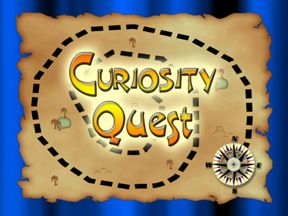
We were so very fortunate to have a chance to review the DVD Combo Pack – Produce and DVD Combo Pack – Swimmers of the Sea by Curiosity Quest!
WHAT IS IT?
The DVD Combo Pack – Produce is a collection of three episodes that discuss how some familiar everyday foods go from the farm to the table. You’ll learn how mushrooms, cranberries, and oranges are grown, harvested, and packaged for consumers all over the world!
Each 30-minute episode will take you out in the fields where the journey begins and take you through the entire process of preparation, growth, harvest, processing, and packing.
You can purchase this combo pack for just $24.95.
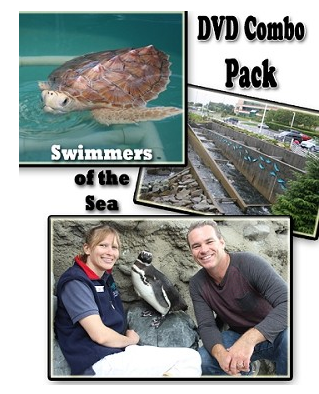
The DVD Combo Pack – Swimmers of the Sea is a collection of three episodes that give you a look at the life of the penguin, the life cycle of the Alaskan salmon, and an intimate view of sea turtles.
Each 30-minute episode will give you up-close insight into the amazing world in which these creatures live and the challenges they each face to survive.
You can purchase this combo pack for just $24.95.
These combo packs are recommended for kids ages 7-14.
OUR EXPERIENCE:
The DVD Combo Pack – Produce included 3 separate episodes chronicling the processes by which mushrooms, cranberries, and oranges are all grown, harvested, and packaged for consumers. There was so much interesting information in these episodes that we could barely resist the urge to watch them all in one sitting, despite how late it was when we started! I took lots of notes and kept thinking to myself that you could easily have your child write a paper on what they’d learned by watching, because these videos are absolutely packed with fascinating facts you have probably never heard before! Even for me as an adult, I learned so much from these shows! I’m going to talk about each episode individually to give you an idea of just how meaty these episodes really are.
The first episode we watched was about mushrooms.  It started by taking us to a large mushroom farm. We learned that mushrooms are not a vegetable but a fungus. That was news to my 9-year old (and confirmation of why she won’t eat them!). The farmer said people mostly consume white or portabella mushrooms, and those were the ones featured in this episode. Mushrooms grow from spores, which are too small to be seen. You might wonder, then, how a mushroom farmer plants something he can’t see. Farmers grow them from spawn, which is a fungus on top of a rye grass seed. Once the rye grass seed has been inoculated by those mushroom spores, they can be planted to grow the mushrooms. Makes sense, right? I’ll bet you didn’t know that. It was news to me!
It started by taking us to a large mushroom farm. We learned that mushrooms are not a vegetable but a fungus. That was news to my 9-year old (and confirmation of why she won’t eat them!). The farmer said people mostly consume white or portabella mushrooms, and those were the ones featured in this episode. Mushrooms grow from spores, which are too small to be seen. You might wonder, then, how a mushroom farmer plants something he can’t see. Farmers grow them from spawn, which is a fungus on top of a rye grass seed. Once the rye grass seed has been inoculated by those mushroom spores, they can be planted to grow the mushrooms. Makes sense, right? I’ll bet you didn’t know that. It was news to me!
The film showed us how the farmer slowly breaks down regular hay by adding raw materials to it and keeping it moist with water. As it decomposes in the sun, the hay gets darker and darker until it’s eventually black like soil. The farmer uses a machine to rotate the hay in the big piles regularly and tests the internal temperature of the stacks. When it reaches 173 degrees, the compost is ready to be spread into wooden trays where the spawn is planted. Those trays are stacked on racks in a climate controlled environment that keeps the humidity and temperature just right for the mushrooms to grow. In fact, they can adjust this climate in order to control how large the mushrooms can grow.
Once some of the mushrooms are ready for harvesting, pickers are brought in to harvest them. They only pick some of them, leaving room for smaller ones to continue to grow. They trim the mushrooms as they pick them and drop them into four baskets, sorting them by their size. Imperfect white mushrooms are separated out to be used for things like pizzas. Believe it or not, each picker can harvest 104 lbs. of mushrooms per hour! That’s a lot! Then the sorted baskets are sent for packaging.
With portabellas, pickers thin out the smaller ones so that they grow much larger. Portabellas grow very quickly, in a matter of just a a few days. Portabellas have very thick, meaty centers, and they are sliced and packaged for consumers. Ends and pieces of portabellas are separated out to be used for things like soups.
 The next episode was all about cranberries. The cranberry growing season begins in March-April, and they are harvested in September-November. You’ll probably be surprised to find out that cranberries actually grow on vines in fields, much like other plants. They are NOT grown in water! However, each cranberry has four hollow chambers inside that cause them to float in water. So farmers flood the fields at harvest time so the cranberries will float to the surface, making them easier to harvest. A machine separates them from the vines and then they can be carefully collected.
The next episode was all about cranberries. The cranberry growing season begins in March-April, and they are harvested in September-November. You’ll probably be surprised to find out that cranberries actually grow on vines in fields, much like other plants. They are NOT grown in water! However, each cranberry has four hollow chambers inside that cause them to float in water. So farmers flood the fields at harvest time so the cranberries will float to the surface, making them easier to harvest. A machine separates them from the vines and then they can be carefully collected.
Not all cranberries are red. In fact, many of them stay green. While they taste the same either way, they are not as visually appealing when they are green, so when they are sent for processing, a machine separates out the green ones from the red ones. Stray pieces of vine are also removed at this stage. They all of the cranberries are carefully dried to prevent the growth of mold and mildew. Once they are dried, they are placed in a cooler for storage. As they are ordered by customers, they are removed from the cooler and bounced off a piece of wood. If the berry bounces, it is good. If it doesn’t bounce, it’s not as good. The second grade berries and any small ones are generally used for cranberry juice. Only the best are used for fresh cranberries. Rejects are fed to wildlife. They can be fed to chickens to keep them healthy. Surprisingly, cranberries are an ingredient in over 1,000 food and beverage products! They are cholesterol free, fat free, and full of antioxidants, making them good for heart health.
The fresh cranberries are packaged in bags, 8 per case, and sent to market. Other cranberries that are used for Craisins and juices are harvested and processed in just an hour! Tractors knock them off the vines, and then they are floated into a corner of the the field and collected.
The last episode on this disc was about oranges. Oranges are picked by hand, because people are gentler than machines, and the growers don’t want bruising to occur on the fruit. 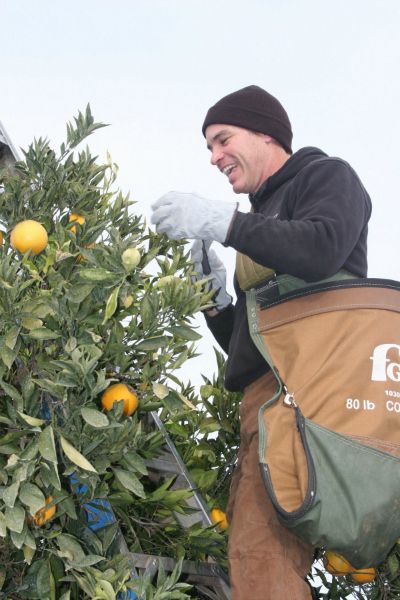 Bruising causes spoilage to occur over time. Pickers can get as many as 500-800 oranges from one tree over the growing season! The oranges may still be green when picked.
Bruising causes spoilage to occur over time. Pickers can get as many as 500-800 oranges from one tree over the growing season! The oranges may still be green when picked.
Navel orange trees bloom in the spring and are harvested in the winter. Valencia orange trees bloom in the spring, as well, but are not harvested until the summer of the following year. These oranges are used for juice.
Growers run wind machines above the trees that blow the warmer air up high down towards the orchard to keep the fruit just a bit warmer and help prevent freezing. These are used at night when the temperatures are in the 20’s and 30’s.
After picking, the oranges are taken to the packing house for further processing. They are treated with ethylene gas for a couple of days to accelerate ripening. This is just like sticking bananas in a paper bag so the gas they emit will ripen them faster. They are washed with chlorine and water to destroy fungus. Then, under black lights, workers remove any oranges that have a yellow glow anywhere on them. This reveals blemishes or injuries to the fruit that they might not otherwise notice. Then the oranges are sprayed with bicarbonate water to remove the chlorine. They are sprayed under high pressure to remove fungus. Brushes underneath remove dust and dirt. Foam rollers remove the water and help dry the oranges.
As the oranges roll by, a machine takes photos of them and determines any off-color or odd shapes and ejects those oranges for juicing. Then it sorts the oranges into categories of perfect, medium grade, and questionable. Workers do additional visual sorting of the questionable ones to make a definitive determination as to their condition. The good oranges become packed, the imperfect ones become juiced, and the bad ones become culled for cattle feed. Then the good oranges are further sorted by machines by their size, and stickers are put on each fruit to be sent to stores.
The DVD Combo Pack – Swimmers of the Sea contained 3 episodes that taught us about Magellanic Penguins, Sea Turtles, and Alaskan Salmon. I continued taking notes through each episode, and my notes literally ran off the bottom of each sheet of paper! These videos are so packed with great information. My 14-year old son joined us for some of these episodes, and even he really enjoyed them and learned some new information.
Magellanic penguins got their name because they were first discovered by Ferdinand Magellan. These penguins don’t need ice and snow to survive. They have 100 feathers per square inch! Aquariums prepare their food with added vitamins to keep their feathers healthy. These penguins weigh between 5.5 and 12 pounds. They eat about 1/2 pound of food per day. Once a year, they molt their feathers and re-grow new ones. This requires a lot of energy, so they generally will eat more just before this molting process begins. They like to eat herring and capelin fish.
These penguins don’t need ice and snow to survive. They have 100 feathers per square inch! Aquariums prepare their food with added vitamins to keep their feathers healthy. These penguins weigh between 5.5 and 12 pounds. They eat about 1/2 pound of food per day. Once a year, they molt their feathers and re-grow new ones. This requires a lot of energy, so they generally will eat more just before this molting process begins. They like to eat herring and capelin fish.
Their wings can be called flippers because they do not fly but swim underwater. Birds that fly have hollow bones to make them light, but birds that swim instead have dense bones to support them in their swimming. Penguins preen (or clean) their feathers regularly, and they help preen each other. They have very short legs, which is what causes the typical waddling that comes to mind when you think of penguins.
The females are smaller than the males. Even in captivity, the penguins practice “porpoising,” which is a means of swimming they use to help evade predators in the wild. They spend most of their lives in the ocean, but they can also rather awkwardly move about on land. Penguins do not typically mate for life.
The next episode was about sea turtles. Rehab centers rescue troubled or sick sea turtles of all kinds. Green sea turtles are herbivores and eat sea grass. Loggerhead turtles are car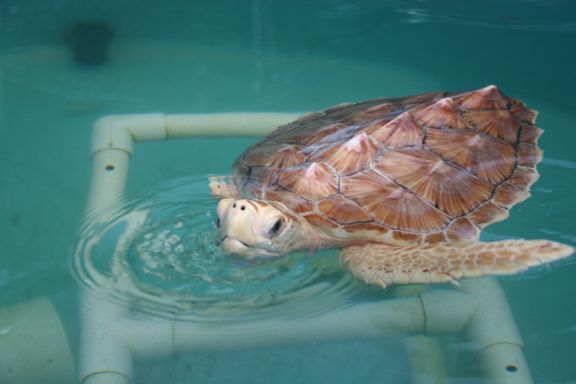 nivores and eat squid, lobster, and crabs. Rescuers add catfish protein to their diets to help rehab the sick sea turtles.
nivores and eat squid, lobster, and crabs. Rescuers add catfish protein to their diets to help rehab the sick sea turtles.
Sea turtles are cold-blooded and have a slow metabolism. They have a beak like a bird rather than jaws. The leatherback is the largest of the sea turtles and can weigh up to one ton!
There are very few Kemp’s Ridley turtles left. They only nest on two beaches in the world, so they are very protected. Hawksbill sea turtles are critically endangered.
Baby sea turtles have a yolk sac on their backs, and that’s how they get nutrition when they’re in the eggs. After hatching, they continue to get some nourishment from the yolk sac until it disappears. Once it disappears, they are totally dependent upon their diet to survive. When they hatch, they follow the light of the moon into the ocean. Mother turtles will always return to the same beach in which they were hatched to nest their own eggs. Turtles rarely lay eggs in captivity.
Loggerhead sea turtles can crush a conch shell with their beak, so handlers have to be especially careful when feeding them or they could take off a human hand!
Newly rescued turtles are kept in individual tanks so keepers can control their food and medicines as they are individually rehabbed. Sea turtles can live 70-100 years! They are the oldest kind of animal on earth, dating back to the days of the dinosaurs. Sea turtles are protected by the government, so it is illegal to touch one, and even rehab centers have to get a special permit to be able to handle them so they can help them when they are sick.
Sea turtles are surprisingly able to swim at 35 mph!
The last episode on this disc is about Alaskan salmon. Salmon find their way back to the same stream wh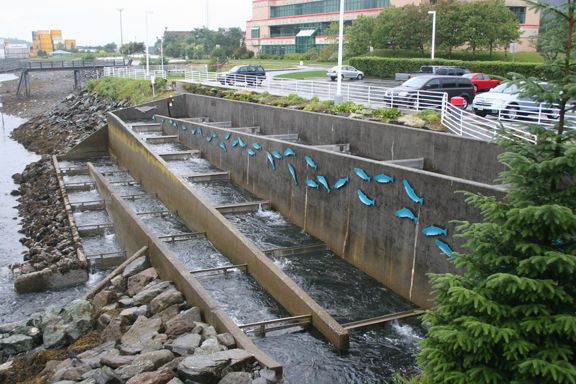 ere they were born when its time to spawn. There are 5 species in Alaska: Pink, Sockeye, Chum, King, and Silver. Most of America’s salmon come from Alaska.
ere they were born when its time to spawn. There are 5 species in Alaska: Pink, Sockeye, Chum, King, and Silver. Most of America’s salmon come from Alaska.
The process of imprinting (learning where you come from) happens in the first five months of life, and they learn the scent of their stream so they can return at the end of their lives to spawn. They spawn in fresh water and lay eggs in the gravel. Different varieties like different types and sizes of rocks for spawning.
King salmon are the largest Pacific salmon and can be up to 100 pounds each!
Salmon live for 3-5 years (up to 7 for Kind salmon). They hatch in fresh water streams, but they live their lives in the ocean’s saltwater before returning to their original fresh water stream to spawn. This is what it means to be anadromous.
We have fish hatcheries to help ensure that wild salmon do not become depleted. Netpen facilities help spread the salmon around so they return to multiple streams to spawn. 2-10% of those from hatcheries will return to spawn. The rest are captured by commercial fisherman for human consumption. After the salmon spawn, they die. This is the end of their life cycle. Each net pen structure can hold 3 million babies for 3 months before they are released. Some salmon migrate as far as Japan before returning to spawn.
King salmon have to be in fresh water for two years before they’re able to breathe saltwater. They eat shrimp and krill and other fish.
As you can see, my kids and I learned SO much information on each of these topics. The videos were interesting and engaging and kept our attention throughout. The host is funny and even a little bit silly at times, but always very entertaining. These episodes are highly educational, but they’re so fun that the kids didn’t even think of them as educational, and they looked forward to each new episode. They could easily be used in a unit study or as a basis for a research paper.
I saw on the Curiosity Quest website that many of the episodes also air periodically on many PBS stations across the nation. I would highly recommend that you check out the many available DVD’s on their website!
I also noticed that Curiosity Quest offers a homeschool subscription that includes two DVD’s a month and a curriculum to accompany it for either a monthly or an annual subscription price.
See what other Crew members had to say about these DVD Combo Packs from Curiosity Quest by clicking the banner below.


No comments:
Post a Comment